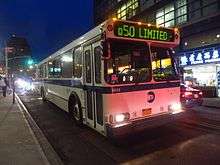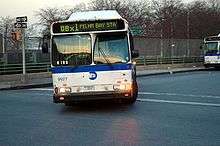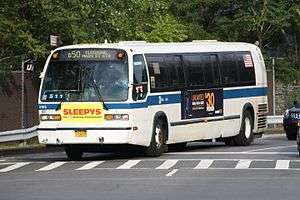Flushing–Co-op City buses
| Bx23 / Q50 Limited | |||
|---|---|---|---|
|
Pelham Bay−Co-op City Flushing–Bronx Former QBx1 | |||
|
| |||
|
| |||
| Overview | |||
| System | MTA Regional Bus Operations | ||
| Operator | MTA Bus Company | ||
| Garage | Eastchester Depot[1] | ||
| Vehicle | |||
| Began service | September 12, 2010 (Bx23 & Q50)[2][3][4][5] | ||
| Route | |||
| Locale | The Bronx; Queens | ||
| Start |
Q50: Flushing, Queens – 39th Avenue / Main Street station Bx23: Pelham Bay, Bronx – Pelham Bay Park station | ||
| Via | Co-op City Boulevard | ||
| End |
Co-op City, Bronx Bx23: Via Sections 1-2-3-4-5 or 5-4-3-2-1,[lower-alpha 1] Bx23: 1,083,926 (2014)[8] | ||
| Fare | $2.75 (MetroCard or coins) | ||
| Cash | Coins only (exact change required) | ||
| Transfers | Yes | ||
| Timetable | Bx23 Q50 | ||
| |||
The Bx23 and Q50 bus routes constitute a public transit corridor running between the Pelham Bay and Co-op City neighborhoods in The Bronx, New York City, United States. The two routes serve all five numerical sections of Co-op City, with the Q50 providing limited-stop service, and the Bx23 running clockwise or counterclockwise service through the neighborhood beginning and ending at a major bus-subway connection at Pelham Bay Park. The Q50 continues south of Pelham Bay into the borough of Queens, terminating at the Flushing – Main Street subway station. Both routes are city-operated under the MTA Bus Company brand of MTA Regional Bus Operations, the only two local routes in the Bronx to operate under MTA Bus.
The two routes are the successor to the QBx1 route, privately operated by the Queens Surface Corporation until 2005, and later operated by MTA Bus. This route ran several confusing service patterns between Co-op City and Pelham Bay, with only select runs continuing to Flushing. In September 2010, the QBx1 was split into the Bx23 and Q50 to simplify service in the Bronx, and provide full-time service between Queens and the Bronx.[2][3][4][5]
Route description and service
Former QBx1
The original QBx1 service began at the Flushing – Main Street subway station in Downtown Flushing, Queens (within a section of Flushing also known as Flushing Chinatown). It ran north on Main Street to Northern Boulevard, then east to Linden Place. It then ran north on Linden Place to the Whitestone Expressway, sharing the street with the Q25 and Q34. The QBx1 proceeded north on the Whitestone Expressway service road and then onto the Bronx–Whitestone Bridge crossing into the Bronx, and then onto the Hutchinson River Parkway service road to Lafayette Avenue. This portion of the route north of the bridge was shared with the Q44, the only other local bus between the Bronx and Queens. At the Bruckner Interchange, the QBx1 turned onto Bruckner Boulevard (the Bruckner Expressway service road), traveling east then north to the Pelham Bay Park station. Only selected buses ran between Flushing and Pelham Bay; most QBx1 runs remained in the Bronx.[2][3][9][10][11][12][13][14]
North of Pelham Bay Park, the QBx1 ran several different services to different parts of Co-op City. The full route circumscribed the entire development, running (clockwise) north along the New England Thruway service road to Bartow Avenue (near the current Bay Plaza Shopping Center), through Section 1, via the Dreiser Loop, through Sections 2 and 3, via the Asch Loop in Section 4, and through Section 5 before returning to Pelham Bay. This pattern operated clockwise (sections 1-2-3-4-5) or counterclockwise (sections 5-4-3-2-1).[lower-alpha 1] The full Flushing−Co-op City service either ran clockwise from Flushing or counterclockwise to Flushing.[2][9][11][12][13][14]
The QBx1 operated a total of ten service patterns, varying on the time of day. During weekday off-peak hours and weekends, the route operated either between Flushing and all five sections of Co-op City, or as a circulatory shuttle service between Pelham Bay and the five sections. During AM peak service, a total of five patterns were used. The three primary AM patterns were Pelham Bay to Bellamy Loop (Section 3) via sections 1-2-3; Pelham Bay to Asch Loop/Section 4 only; Pelham Bay clockwise via Bartow Avenue (Section 4) and Section 5 and return to Pelham Bay. The intermittent service to and from Flushing ran via the Bellamy Loop route. The three PM peak hour services were Flushing−Pelham Bay−Bellamy Loop; Pelham Bay−Bellamy Loop; Pelham Bay−Section 5−Section 4/Asch Loop−Pelham Bay (counterclockwise).[lower-alpha 1][2][9][11][12][13][14] While this structure provided direct service to individual sections of Co-op City, the structure was considered confusing and inconvenient due to the many different service patterns under one route designation, and the lack of service between Queens and the Bronx.[2][3][13]
Current bus service

The Bx23 constitutes a simplified version of the former QBx1 route between Pelham Bay Park and Co-op City, running either clockwise (1-2-3-4-5) or counterclockwise (5-4-3-2-1) before returning to Pelham Bay. The Q50, meanwhile, runs between Co-op City and Flushing via Pelham Bay, with its northern terminal at Erskine Place and Earhart Lane in Section 5. Q50 buses travel clockwise in Co-op City northbound, and counterclockwise southbound. The Q50 also employs limited-stop service, making fewer stops in Queens and bypassing the individual loops of Co-op City served by the Bx23. The routes run at all times except late nights; at these times, Co-op city service is replaced by the Bx28, while there is no direct Bronx-Queens service.[6][7][15][16][17][18]
At Pelham Bay Park, both directions of Bx23 and Q50 service share three adjacent bus stops on the southbound Bruckner Boulevard to the south of the subway station. The southernmost stop at the intersection of Bruckner and Amendola Place is used by Flushing-bound Q50 service. The middle stop is used by all clockwise Co-Op City service (Q50s to Section 5 and Bx23s via 1-2-3-4-5). The northernmost stop is used by Bx23s operating the counterclockwise loop. Because of this setup, Bronx-bound Q50 buses must U-turn at Westchester Avenue to stop at Pelham Bay, then U-turn again towards Co-op City.[17][18]
Prior to 2014, the Bx23 employed additional service patterns during rush hours, similar to its predecessor route. Buses would travel via 1-2-3-4 (AM rush) or 4-3-2-1 (PM rush) and return to Pelham Bay, or directly to Section 5 via Bartow Avenue/Bay Plaza/Section 4 (clockwise AM; counterclockwise PM) and return to Pelham Bay. This was eliminated to maintain one consistent service pattern at all times, and allow service between all sections of Co-op City at all times.[2][19]
The Bx23 and Q50 are two of the several local bus routes to serve Co-op City, which is heavily dependent on bus service. They are among five routes (along with the Bx5 on weekends, Bx12 SBS, and Bx29) to feed into Pelham Bay Park station from the neighborhood, and the only two to serve all five sections of the development (except for the late night Bx28 service).[2][16]
History

The QBx1 was in operation since at least the 1970s under the Queens Transit Corporation, labeled the "Bx1" on Queens bus maps.[20] The route originally operated between Flushing and Pelham Bay Park.[21] By 1985, the QBx1 was extended to Co-op City.[22] The bus company would become Queens-Steinway Transit Corporation in 1986, and Queens Surface Corporation in 1988.[23]
In April 1994, bike racks were installed onto QBx1 buses to carry bicycles over the Whitestone Bridge. This was the first bike-on-bus program in the city.[24] The service was offered on a seasonal basis (April to September), with pick-up/drop-off points at 20th Avenue in Whitestone, Queens and Lafayette Avenue near Ferry Point Park in the Bronx.[25]
On February 27, 2005, the MTA Bus Company took over the operations of the Queens Surface routes, part of the city's takeover of all the remaining privately operated bus routes.[26][27] As part of the takeover, the bike-on-bus program was eliminated;[28] the next program would be implemented by the MTA on the S53 and S93 routes in Staten Island in September 2015.[3][29]
In 2009, ten buses from the Eastchester Depot near Co-op City (the former New York Bus Service depot) began to operate on QBx1 service.[30] Two additional stops in the Bronx were added to the route in June 2010, at Baisley Avenue (southbound) and Kearny Avenue (northbound) both at Bruckner Boulevard, to connect with a pedestrian overpass to the Country Club neighborhood.[31]
On September 12, 2010, the QBx1 was split into the Q50 Limited and Bx23 routes, simplifying the many service patterns of the former QBx1 route, but eliminating direct service between Pelham Bay and the individual sections of Co-op City.[2][3][4][5] In addition, the changes were made in conjunction with controversial cuts in service to other Co-op City routes during the MTA's 2010 budget crisis, and received negative input from the community.[2][4][32][33][34]
On June 29, 2014, the rush hour service pattern of the Bx23 was eliminated, with the off-peak pattern going into effect at all times. In addition, a stop on the Bx23 was added at Adler Place in the Asch Loop. A stop for the Q50 was also added outside the Dreiser Loop.[2][33][35][36]
Notes
- 1 2 3 4 The sections are:[2]:A III
- Section 1 is the northwestern section, north of Harry Truman High School.
- Section 2 is the northeastern section, east of Harry Truman High School.
- Section 3 is the western section, west of Bartow Mall Shopping Center.
- Section 4 is the eastern section, east of Bartow Mall Shopping Center.
- Section 5 is the southeastern section, east and south of the Hutchinson River Parkway.
Q50: Section 5[lower-alpha 1] – Earhart Lane and Erskine PlaceServiceOperates All times except late nights[6][7]Daily ridership Q50: 1,398,766 (2014)<ref name='ridership'>"Facts and Figures". mta.info. 2011-08-28. Retrieved 2016-01-19.
References
- ↑ "MTA Bus: Eastchester Depot Pick Glossary; Effective: 09/04/2016". MTA Bus Company. 2016. Retrieved 7 August 2016.
- 1 2 3 4 5 6 7 8 9 10 11 12 "Review of Bus Service & Performance in Co-op City with Recommendations for Service Enhancements" (PDF). Metropolitan Transportation Authority. January 2014. Retrieved 11 December 2015.
- 1 2 3 4 5 6 "Northeast Queens Bus Study" (PDF). Metropolitan Transportation Authority. September 2015. Retrieved 11 December 2015.
- 1 2 3 4 Reyes, Lennin (November 24, 2011). "Confusing Bus Riders One Cut at a Time". The Bronx Journal. Retrieved 26 September 2015.
- 1 2 3 "MTA Bus Service Changes". Metropolitan Transportation Authority. November 2010. Archived from the original on 2010-11-25. Retrieved 1 January 2016.
- 1 2 Bx23 bus schedule MTA Regional Bus Operations.
- 1 2 Q50 bus schedule MTA Regional Bus Operations.
- ↑
- 1 2 3 "QBx1 Bus Timetable: Effective Fall 2009" (PDF). MTA Bus Company. 2009. Retrieved 11 January 2016.
- ↑ "Queens Bus Map: Notes" (PDF). archive.org. mta.info. December 2002. Archived from the original (PDF) on 2003-03-23. Retrieved 6 July 2015.
- 1 2 3 "Bronx Bus Service: December 2002" (PDF). Metropolitan Transportation Authority. December 2002. Archived from the original (PDF) on 2004-03-17. Retrieved 26 September 2015.
- 1 2 3 Urbitran Associates, Inc (May 2004). "NYCDOT Bus Ridership Survey and Route Analysis Final Report: Chapter 3 Transit System Characteristics" (PDF). nyc.gov. New York City Department of Transportation. Retrieved 16 October 2015.
- 1 2 3 4 Urbitran Associates, Inc (May 2004). "NYCDOT Bus Ridership Survey and Route Analysis Final Report: Chapter 4 Operating and Financial Performance" (PDF). nyc.gov. New York City Department of Transportation. Retrieved 20 December 2015.
- 1 2 3 "Appendix B: Route Profiles" (PDF). nyc.gov. New York City Department of Transportation. Retrieved 8 November 2015.
- ↑ "Queens Bus Map" (PDF). Metropolitan Transportation Authority.
- 1 2 "Bronx Bus Map" (PDF). Metropolitan Transportation Authority.
- 1 2 "MTA Bus Time: Bx23 Pelham Bay - Co-Op City". mta.info. MTA Bus Time.
- 1 2 "MTA Bus Time: Q50 Co-Op City/Pelham Bay - Flushing". mta.info. MTA Bus Time.
- ↑ "Bx23 schedule: Effective Spring 2013" (PDF). MTA Bus Company. 2013. Archived from the original (PDF) on 2013-07-21. Retrieved 18 February 2016.
- ↑ "1975 Queens Bus Map". wardmaps.com. New York City Transit Authority. 1975. Retrieved 18 February 2016.
- ↑ Poust, Mary Ann (December 6, 1982). "Bronx bus routes to change" (PDF). Gannett Westchester Newspaper. Fultonhistory.com. Retrieved 11 January 2016.
- ↑ Fried, Joseph P. (August 14, 1985). "STRIKE OF 4 BUS LINES DISRUPTS TRAVEL FOR THOUSANDS IN QUEENS AND BRONX". The New York Times. Retrieved 11 January 2016.
- ↑ Roger P. Roess; Gene Sansone (23 August 2012). The Wheels That Drove New York: A History of the New York City Transit System. Springer Science & Business Media. p. 273. ISBN 978-3-642-30484-2.
- ↑ "New York City Bicycle Master Plan" (PDF). nyc.gov. New York City Department of Transportation, New York City Department of City Planning. May 1997. Retrieved 11 January 2016.
- ↑ "NYC Cycling Map: The Bronx, Brooklyn, Manhattan, Queens, Staten Island" (PDF). transalt.org. New York City Department of City Planning, New York City Department of Transportation, New York City Department of Parks and Recreation. 2005. Retrieved 11 January 2016.
- ↑ Silverman, Norman (July 26, 2010). "The Merger of 7 Private Bus Companies into MTA Bus" (PDF). apta.com. American Public Transportation Association, Metropolitan Transportation Authority. Archived (PDF) from the original on 2015-10-16. Retrieved 16 October 2015.
- ↑ Woodberry, Jr., Warren (February 24, 2005). "MAJOR BUS CO. TO JOIN MTA". Daily News (New York). Retrieved 4 January 2016.
- ↑ "The New York City Bicycle Survey: A Report Based on the Online Public Opinion Questionnaire Conducted for Bike Month 2006" (PDF). nyc.gov. New York City Department of City Planning. May 2007.
- ↑ "Racks Available on S53, S93 Routes for 1-Year Pilot Testing Feasibility, Impact to Service". Metropolitan Transportation Authority. August 31, 2015. Retrieved 9 March 2016.
- ↑ Boyle, Daniel; Pappas, John; Boyle, Phillip; Nelson, Bonnie; Sharfarz, David; Benn, Howard (March 2009). "Appendixes to TCRP Report 135: Controlling System Costs: Basic and Advanced Scheduling Manuals and Contemporary Issues in Transit Scheduling" (PDF). Transportation Research Board. Retrieved 11 January 2016.
- ↑ Post Staff Report (June 3, 2010). "New bus routes should satisfy all". New York Post. Retrieved 11 January 2016.
- ↑ "2010 NYC Transit Service Reductions - Revised". Metropolitan Transportation Authority. March 19, 2010. Archived from the original (PDF) on 2011-02-25.
- 1 2 Cunningham, Jennifer H. (January 29, 2014). "Bus service back on track in Co-op City: MTA OK's bus service upgrades in Co-op City after slashing service in 2010". Daily News (New York). Retrieved 11 January 2016.
- ↑ Stuttig, Bill (May 25, 2013). "Bus service restoration to be the focus of two townhall meetings set for Wednesday in Dreiser Auditorium". Co-op City Times. pp. 1, 4. Retrieved 11 January 2016.
- ↑ "Planned Service Changes: Service adjustment in Co-op City". Metropolitan Transportation Authority. June 29, 2014. Retrieved 11 January 2016.
- ↑ "Planned Service Changes: New Bus Stops in Co-Op City". Metropolitan Transportation Authority. 2014. Retrieved 11 January 2016.
External links
-
 Media related to Flushing–Co-op City buses at Wikimedia Commons
Media related to Flushing–Co-op City buses at Wikimedia Commons - Review of Bus Service & Performance in Co-op City with Recommendations for Service Enhancements – MTA (January 2014)

